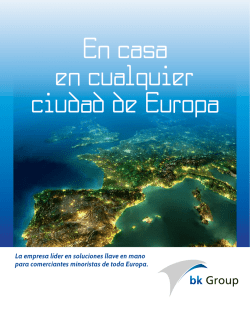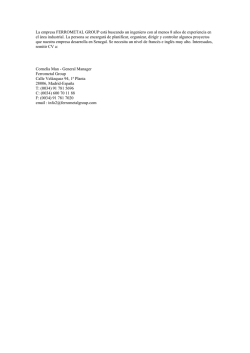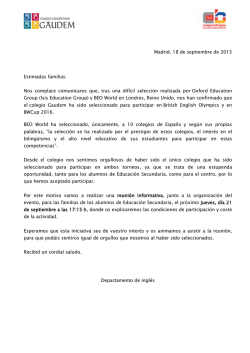
UNIVERSIDAD NACIONAL ABIERTA YA DISTANCIA Guía
UNIVERSIDAD NACIONAL ABIERTA Y A DISTANCIA Guía de Actividades Trabajo colaborativo No 2 Task cycle Course:. Phonetics and phonology Code: 551017 Topics:. Consonants – Voicing – Place of articulation – Manner of articulation – Vowels – Front – Central – Back – High – Intermediate – Low - Diphthongs Learning strategy: Task-based learning Weight : 180 points I. Learning goals: Purpose: : This activity has two stages: Written (group) and Oral production (individual). Written work will be developed collaboratively and aims students getting familiar with phonetic symbols of English sounds through application of theory about consonant and vowel production. Then, in a second stage students will record a text producing English sounds accurately. Competences: To Recognize and describe the specific linguistic terms found in phonetics and phonology To identify the parts of the vocal tract and their roles in speech production To transcribe English and non-English speech using the International Phonetic Alphabet (IPA). II. Activity description: Topics reviewed: Consonants – Voicing – Place of articulation – Manner of articulation – Vowels – Front – Central – Back – High – Intermediate – Low - Diphthongs Learning strategy: Task-based learning Previous tasks: Check contents Unit 1 Phonetics Steps for the development of the task: TASK 1 Written stage (Group work) Your tutor will open two themes in the forum. In the “Written stage” topic you should follow these directions: 1. Get familiar with the use of English phonetic sounds. You should learn to identify and produce them. Use all the following resources: Phonemic chart: http://www.teachingenglish.org.uk/activities/phonemic-chart American English Pronunciation: http://pronuncian.com/Sounds/Default.aspx? Learning the sounds: http://www.bbc.co.uk/worldservice/learningenglish/grammar/pron/sounds/ English Accent Coach: http://www.englishaccentcoach.com/ Moreover in the following link, find the IPA for English sounds as a reference: http://www.antimoon.com/how/pronunc-soundsipa.htm 2. Check the e–book in PDF: “Phonetics and Phonology” by Forel & Puskás (2005) in the “Contents” of the course. On pages 20 – 29 there are exercises for the phonetics session of the book. The group must answer the following exercises: 1; 2; 3 (a), (b), (c); 4; 5; 7 (a); 8; 9 (a), (b), (c); 10 (a), (b), (c), (d), (e), (f); 11 (a), (b), (c), (d), (e), (f); 12 (a), (b); 13; 17 (a), (b). 3. The group decides on the way each member will participate. Certain number of exercises can be assigned to each member of the team, for example. 4. Every student in the group must upload in a Word file his/her individual contribution in the forum “Written stage”, giving answer to the chosen questions. The file must be named: first name+last name_act6_group+number of group (e.g. lilianamoreno_act6_group15). Everybody in the group should comment his/her e-mates’ contributions. 5. When the whole group is sure that all questions have been answered, the group leader must assemble all contributions in one word file, with a title page including only the names of students contributed to the task. This file must be named: Act6_Group+number of group (e.g. Act6_Group15). Remember that this document must include all the requested exercises in above number 2 and the links of the audios of TASK 2. TASK 2 Oral production stage Your tutor will open two themes in the forum. In the “Oral production stage” topic you should follow these directions: 1. Each person in the group must register her/his name on a link in order to do the speaking and listening exercise. The tutor will post the link on the forum. The student must have camera on her/her pc for the speaking. The tutor will show a piece of text and the student will read it. Then, the tutor will send a listening exercise about some words, which the student must choice the word he/she heard. If you have any questions, ask your tutor through the course internal mail. Es importante que los estudiantes realicen sus aportes al foro colaborativo tanto individual como colaborativo desde su apertura ya que no se aceptarán intervenciones de última hora. Parte A. Individual work: 115 Development of the assigned exercises by the team on TASK 1 Speaking interview. Parte B. Group work: 65 Putting together the exercises developed by each member of the group on TASK 1 on a word file and uploading the final product on the evaluative environment. III. Criterios de Contenido: el estudiante debe tener en cuenta los siguientes elementos para la presentación argumentada de su trabajo: Coherencia: Según Sánchez (2011), es la conexión lógica que se produce entre el texto el contexto, el género al cual pertenece el texto y el propósito del autor y la define como la correlación entre el propósito del autor del texto, su contenido (estructura y progresión de la información), el sentido y la situación comunicativa. Cohesión: Según Cassany (1999), se define como el conjunto de relaciones o vínculos significativos que se establecen entre diferentes elementos o parte del texto (palabras, oraciones y apartados) que le permiten al lector interpretarlo con eficacia. Redacción: Característica del texto que se traduce en un adecuado manejo del código lingüístico de conformidad con el tipo de texto y su género. Ortografía: Está dada por el conocimiento y aplicación de las reglas tanto de ortografía como de puntuación. Originalidad: Se presentan algunas definiciones de originalidad recopiladas por Phillips y Pugh (2005) citadas por Blaxter (2008): 1) Poner por escrito una cantidad importante de nueva información por primera vez. 2) Llevar a cabo un trabajo empírico que no se ha hecho antes. 3) Hacer una síntesis que no se ha hecho antes. 4) Usar material ya conocido pero con una nueva interpretación. 5) Adoptar una técnica particular y aplicarla a una nueva área. 6) Obtener nuevos resultados sobre un tema viejo. 7). Plagio: ¿Qué es el plagio para la UNAD? El plagio está definido por el diccionario de la Real Academia como la acción de "copiar en lo sustancial obras ajenas, dándolas como propias". Por tanto el plagio es una falta grave: es el equivalente en el ámbito académico, al robo. Un estudiante que plagia no se toma su educación en serio, y no respeta el trabajo intelectual ajeno. No existe plagio pequeño. Si un estudiante hace uso de cualquier porción del trabajo de otra persona, y no documenta su fuente, está cometiendo un acto de plagio. IV Criterios de forma: Hace alusión a los criterios de formales para la presentación del documento escrito y los cuales se recomiendan incorporar en la rúbrica de evaluación. Son los siguientes: (Tomados de la norma APA, versión 3 en Español como traducción de la versión 6 en Inglés) Se espera que los estudiantes realicen paso a paso cada una de los paso/componente presentados anteriormente y que entreguen un solo informe de manera grupal desde los siguientes criterios (1) Editor de texto MS Word para Windows (2) Fuente: Times New Roman (3) Tamaño fuente: 12 (4) Espacio entre líneas (2). (5) Márgenes: izquierda, derecha, superior e inferior de 2,56 cm. (6) Títulos en la fuente, tamaño 12 y centrado. (7) Subtítulos en cursiva, tamaño 12, espacio 2 y alineado al margen izquierdo. (8) Registre todas las referencias de las fuentes bibliográficas, cibergráficas y hemerográficas que le darán soporte teórico, conceptual y metodológico a su trabajo de investigación. (9) El trabajo debe presentarse acorde al formato tanto individual como grupal entregado en anexos. No se debe presentar en formato PDF, ya que no permite la información de retorno por parte del docente. V. Final product: One word file that contains: 1. A title page 2. Written exercises developed by each member of the group VI. References: Kirchner, R. (n.d). Chapter 1 – Phonetics and phonology: understanding the sounds of speech. University of Alberta pages 1 – 10. BBC learning. (n.d). The sounds of English. Retrieved on November http://www.bbc.co.uk/worldservice/learningenglish/grammar/pron/sounds/index.shtml 6th, 2014 from Reithaug, D. (2002). Orchestrating Success in Reading. Retrieved on November 6th, 2014 from http://www.boardman.k12.oh.us/bdms/phonological/44Phonemes.pdf Forel, C. & Puskás, G. (2005). Phonetics and Phonology. Geneva: University of Oldenburg. Pages 3 – 19.
© Copyright 2025




